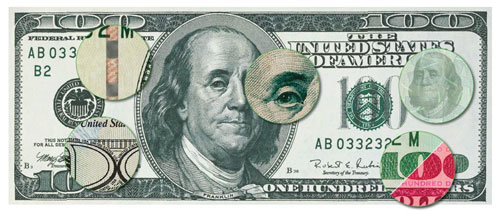

Every single American bank note is printed at Bureau of Engraving and Printing facilities, with ink and on paper each made, separately, in only one factory in the world. And yet at any given time, there is at least $70 million worth of fake U.S. currency floating around, 75 percent of which is in $100 bills. In large part because of the advent of inexpensive scanners and printers, more and more fake bills are entering circulation: From 1997 to 2007, the amount of passed counterfeit bills nearly doubled, to $64.9 million. Professional fakers are making bills that are more convincing than ever.
Blame the digital revolution. “In the early 1990s, only 1 percent of all counterfeit currency was created with high-quality printers, scanners and copiers,” says Michael Merritt, a deputy assistant director for the Secret Service, which is charged with policing counterfeit currency. “Now it’s 56 percent.” One notable offender is Art Williams, Jr., who has been arrested twice in the past decade–and has seven years left on his October 2007 sentence–for printing roughly $10 million in ersatz American currency using a scanner and a high-end printer.
The Secret Service estimates that 75 percent of the $564 billion in U.S. $100 bills are circulating overseas. Because of its high profile and constant, known value, the American hundred has become, in many unstable economies, the de facto currency. But tracking down fakes all over the world is too difficult for one agency. And there are far more sinister counterfeiters and opportunists than millionaire wannabes like Williams. For at least the past two decades, North Korea has been using the same sophisticated money-printing processes as the U.S. to create a “superdollar”–a bill that matches nearly every one of its security features–in order to simultaneously fatten that country’s coffers and devalue the American dollar. (According to the Secret Service, $5.3 million in supernotes were passed in 2005, all as $100 bills.)
So although most of the American financial brain trust is logging extensive server hours to digitize your dough, the BEP is working to protect the hard copies with a combination of tried-and-true tricks and the latest in anti-counterfeiting tech. Once the new bill hits ATMs in the next few years, even the most tech-savvy counterfeiters will be forced to start from square one.
Launch the gallery, to see how a former counterfeiter and director of the U.S. Bureau of Engraving give an inside look at the flaws in the current bill and the tech that will make the next $100 inimitable.




